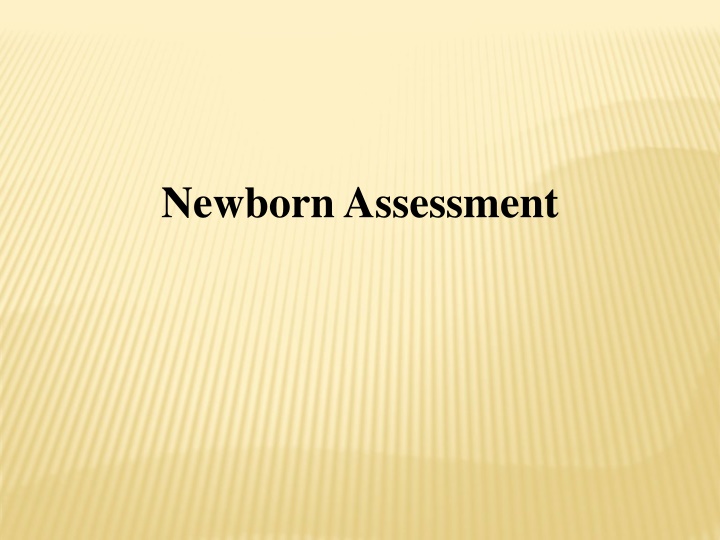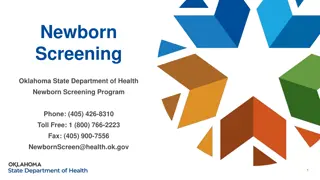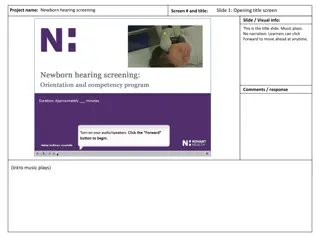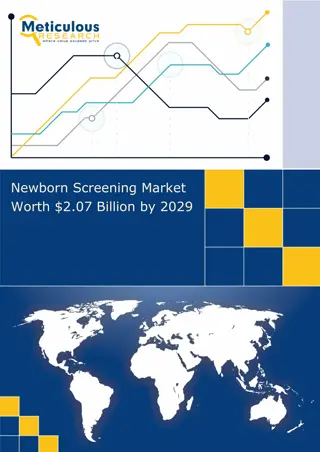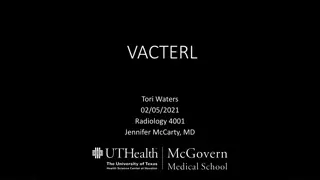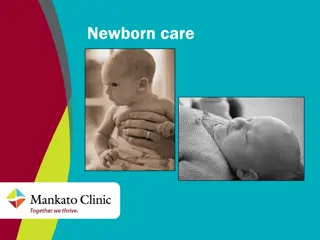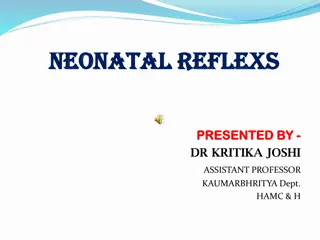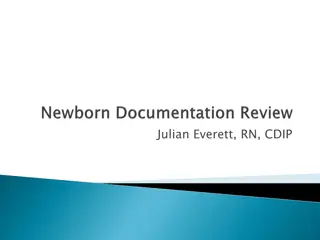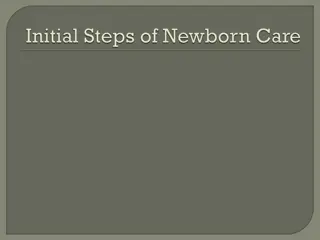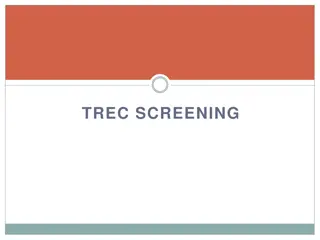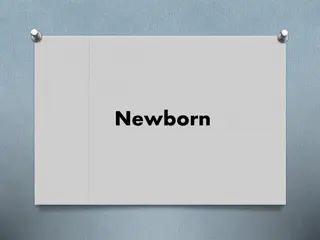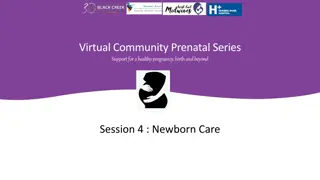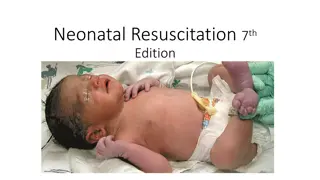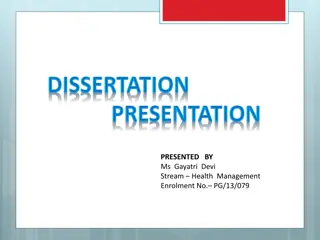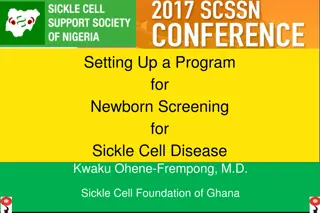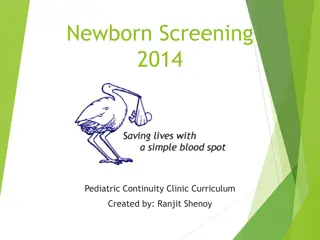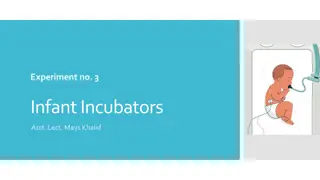Newborn Assessment
Newborn assessment involves a meticulous examination of infants shortly after birth to monitor their physical and mental well-being. This assessment aids in early detection of any health issues and determines the care needed for the baby. Key components include Apgar scoring, growth measurements, and a thorough physical examination. Systematic assessments such as vital sign measurements and general physical checks are crucial in ensuring the overall health of newborns.
Download Presentation

Please find below an Image/Link to download the presentation.
The content on the website is provided AS IS for your information and personal use only. It may not be sold, licensed, or shared on other websites without obtaining consent from the author.If you encounter any issues during the download, it is possible that the publisher has removed the file from their server.
You are allowed to download the files provided on this website for personal or commercial use, subject to the condition that they are used lawfully. All files are the property of their respective owners.
The content on the website is provided AS IS for your information and personal use only. It may not be sold, licensed, or shared on other websites without obtaining consent from the author.
E N D
Presentation Transcript
Outline:- -introduction -Definition -Purpose -Newborn assessment ..Apgar scoring ..Growth measurement ..Physical assessment - Neonatal Care Program
Introduction:- Newborn baby: - a baby from birth to four weeks. Each newborn baby is carefully checked at birth for signs of problems or complications. The healthcare provider will do a complete physical exam that includes every body system.
Definition:- Newborn assessment is defined as the assessment of a recently born infant at various points within the timeframe of first 6 8 weeks after birth. The first instance includes initial assessment, followed by a detailed assessment within 48 hours of birth, and follow-up assessments at 5 7 days and 6 weeks.
Purpose:- *to understand the physical and mental wellbeing of baby. *to detect the cause and the effect of disease in early stage. *to determine the nature of care needed for the baby.
Assessments for Newborn Babies include:- Apgar scoring:- *The Apgar score helps find breathing problems and other health issues. It is part of the special attention given to a baby in the first few minutes after birth. The baby is checked at 1 minute and 5 minutes after birth for heart and respiratory rates, muscle tone, reflexes, and color. *Each area can have a score of 0, 1, or 2, with 10 points as the maximum. Most babies score 8 or 9, with 1 or 2 points taken off for blue hands and feet because of immature circulation. *Apgar scores of 6 or less usually mean a baby needed immediate attention and care.
Systematic physical examination: General measurement Birth weight: 2700-4ooo g. Head circumference: 33-35cm. Chest circumference: 30.5-33cm. Vital signs: Temperature: axillary: 36.5c-37c Heart rate: 40 beats/min. Respiratory:30-60 breaths/min. Blood pressure:65/41mmhg
General appearance: Posture: Flexion of head and extremities while rest on chest and abdomen Skin: At birth, bright red, puffy smooth. Second to third day dark pink and dry. It is soft and has good elasticity or tissue turgor due to hydrate released, it well promptly go back to normal smooth state. Edema is seen around eye, face, legs and scrotum or labia. Cyanosis of hands and feet.
1-vernix caseosa: It is soft yellowish cream; which covers the neonates at birth to protect the skin from infection. It is formed of sebaceous gland mixed with old epithelial cell. It may thickly cover the baby or it my be found only in the body crease and between the labia. It dries off within 24-48 hours and fades spontaneously and rubs off on the infant's clothes. Some nursery units still believe that vernix is a good culture medium for bacterial growth and removes it all.
2 - Lanugo hair: It is along soft growth of fine hair observed on the shoulders, back, extremities, forehead and temples of the neonate. The more premature baby is, the heavier the presence of lanugo is. It disappears during the first weeks of life.
3-Mongolian spots: Mediterranean and Negro babies often manifest black coloration on the lower back, buttocks, anterior trunk and rarely on fingers and feet. They are not bruise mark, or a sign of ill treatment and aren't associated with mental retardation. They disappear during preschool years without treatment.
4-Desquamation Pealing of the skin occurs within 2-4 weeks of life. These are denoted areas where the delicate skin has been rubbed off the nose, knees and elbows, because of pressure and erosion of sheets. The skin of buttocks is particularly sensitive and should not be left wet and /or soiled.
5- Physiological jaundice: Appears 2-3 days after delivery; the skin begins to take on a yellow coloration. This jaundice is not pathological it is associated with excessive destruction of erythrocytes (R.B.C.) that are not needed after birth. It increases after birth. it increases for a few days and usually disappears by the 7-10 days
6- Milia: These are small pinpoint white or yellowspots due to increased fat secretion. Common on the nose, forehead, cheeks, and chin of the newborn infants. They can be felt with the finger they consist of accumulations of secretions from the sweat and sebaceous glands that have not yet begun to function normally . They will disappear within a few weeks (one to two weeks). They should not be expressed.
Head; The fontanels are soft spots. Consist of openings at the point of union of the skill bones. The anterior fontanel: Is diamond in shape and located at the junction of two parietal and fontal bones. it is 2-3cm in width and 3-4 cm in length. It closes between 12 -18 month of age. The posterior fontanel: Istriangular and located between the occipital and parietal bones. It is closes by two month of age. Fontanels should be flat, soft, and firm. It bulges when the baby cries or if there increased intracranial pressure.
Two conditions may appear in the head. These are caput succedaneum and cephalhematoma. - Caput succidaneum: is edema of the scalp resulting from pressure during labor. - Cephalhematoma: is hemorrhage under the periostieum of one of the cranial bones (usually parietal) resulting from trauma of labor.
Eyes: Lids: usually edematous. Color: true eyes color is not determined until the age of 3-6 months. Pupil: react to light or touch Blinking reflex in response to light Rudimentary fixation on object Ears: Position: top of pinna on horizontal line with outer canthus of eye Startle reflex elicited by a loud sudden noise. Pinna flexible, cartilage present.
Nose Nasal potency. Nasal discharge-thin white mucous. Mouth and throat Intact, high-arched palate. Uvula in midline Sucking reflex. Gag reflex. Minimal salivation. Neck: Short, thick, usually surrounded by skin fold tonic neck reflex present.
4- General nursing management of the new born A- Vital signs: Vital signs should be taken twice a day. B- Temperature maintenance. C- Growth measurement D- Infection control E- observation: o Meconium and urine passage o Umbilical cord observation for hemorrhage of cord o Neonate's behavior o Any abnormalities: such as hypothermia, hemorrhage of cord, hyperthermia, bradycardia and any changes in neonate's behavior.
F- B.C.G. Vaccination G- Promote parent-infant bonding by health teaching. 5-Nutrition: Breast and Bottle feeding Feeding Types of feeding 1- Breast-feeding: the best for the healthy infant. 2- Artificial feeding (Bottle-feeding): Types of milk Breast milk. Standard formula. Special formulas: low phosphate ..etc.
Weight gain All neonatal lose 5 l0% of their body weight in the first few days after delivery. Preterm infant's weight. (Have higher body water content) may lose more weight If they are sick, these preterm infants may lose up 15-20% Ii is important to early introduce some form of supplementary IV feeding (refer to TPN They usually regain birth weight by 2 weeks. Taking longer time in the more premature babies Calories needed The newborn infant needs about 100-120 K /kg/day for normal growth, this being achieved over the l week.
6-Hygiene Sponge baths will suffice until the cord stump has dried and fallen off. Bathing is usually doing after the vital sign have stabilized, especially the temperature. The bath should processed form head to toe, with special attention paid to folds of skin. To maintain temperature, the infant should be completely dried after each bath. Cradle cap is seen in some infants. It appears as thick, yellow, scaly patches that are found on the scalp, but that may also appear on the eyebrows or eyelids. The scales may be removed by warming a small amount of baby oil, applying it to the patches and allowing it to penetrate the crusts. Cord care after each bath and diaper change. The diaper area, including the gluteal folds, should be cleaned and thoroughly dried with each diaper change. Either warm water or baby wipes can be used.
7- Elimination Infants frequently have a stool with each feeding and may avoid as many as 20 times per day. Parents should be taught that their infant should have at least one stool.
Classification of new born Classification of newborn by weight and gestational age (Help in predict potential problems) Low Birth Weight (LBW): <2500gm Very Low Birth Weight (VLBW): <1500gm Extremely low birth weight infant(ELBW): <1000gm Term :completed 37 weeks gestation till 42 week Premature; less than 37 weeks gestation.
Newborn Baby Health Insurance New babies require many well-baby visits and immunizations and it is necessary to make sure that you have adequate health insurance. The contents of the health card for newborn Health Card (Male and Female): Every child card has health record in a special register office of the competent health delivered to the mother or father. Containing official immunization schedule, growth chart
Divided the health card for the females to: 1- A special part of health care for children from birth to preschool age 2-A special part of health care for school age 3- A special part of health care after the age of school 4 - A special part of health care for girls of 12 18years 5- Part of a special examination before marriage 6- A special part of health care for the mother during pregnancy and childbirth is a duplicate of the number of 3 times Of pregnancy. 7- A special part of health care between the periods of pregnancy 8- A special part of health care for women after child-bearing age
Components of the health card for males 1- Special part of health care for children from birth to school age 2- A special part of health care for school age 3 -Pages of private health care after the age of school 4 -Special pages examination before marriage
Neonatal care program 1.Screening program for congenital hypothyroidism 2.Nutritional programs 3. Integrated Management of Childhood Illness 4-The Expanded Program on Immunization (EPI) 5-The Expanded Program on Immunization (EPI)
